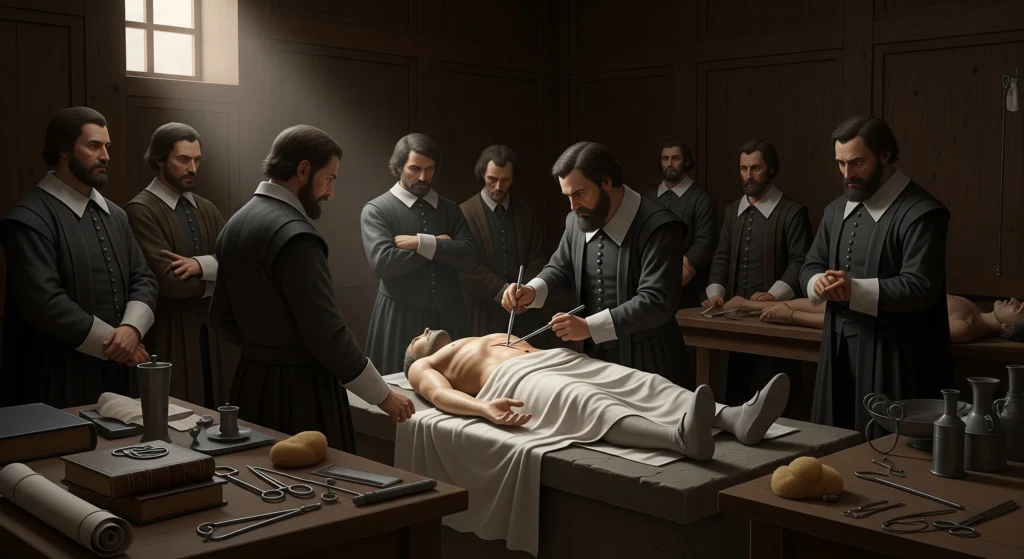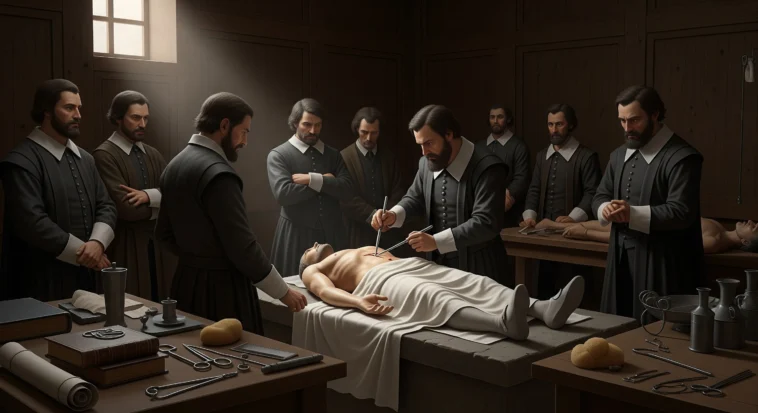The practice of autopsy is basically humanity’s first deep dive into “How does this thing actually work?” It’s one of medicine’s coolest detective tools—yet almost no one stops to ask who did the very first one. Spoiler: it goes way back. Ancient civilizations were already brave enough-and curious enough-to explore the human body to solve various medical mysteries well before modern science existed. It’s like a backstage pass to how we function, and our ancestors took that tour long before we gave it a name.

Understanding Autopsy: A Brief Overview
Before we time-travel into ancient history, let’s get clear on what an autopsy actually is. Think of it as the ultimate medical detective mission. An autopsy—also called a post-mortem exam—is when trained professionals carefully examine a person’s body after they’ve passed away. They do this to:
- Figure out what really caused the death
- Spot diseases or injuries that might’ve been hidden
- Help doctors learn more about how the body works
- Double-check if medical diagnoses were accurate
- Provide crucial clues in criminal cases (yep, real-life CSI stuff)
- Teach future doctors and power scientific research
It’s such an essential part of modern medicine that imagining healthcare without it is like imagining a crime show without the big reveal scene. But getting from the very first documented autopsy to the high-tech forensic labs we see today? That journey took thousands of years, crossed continents, and involved some seriously curious humans who weren’t afraid to ask, “What’s really going on inside us?”
The Ancient Egyptian Contribution: Mummification and Early Examination
When we talk about the earliest “autopsy-like” practice, we have to start with ancient Egypt. Now, they weren’t doing autopsies the way doctors do today—no detective work, no “CSI: Nile River Edition.” But their mummification process (starting around 3500 BCE!) did require embalmers to remove and handle organs with surprising skill.
These embalmers knew where each organ was, created special tools, and even figured out that different organs needed different treatments. Basically, they accidentally became early anatomy experts. But here’s the twist: they weren’t allowed to study the body for medical reasons—religion said “preserve for the afterlife,” not “solve medical mysteries.”
So while Egyptians were the first to explore the inside of the human body in a systematic way, they weren’t doing autopsies in the true scientific sense. They were preparing people for their next life—not trying to understand what happened in this one.
Ancient Greece: The Birth of Medical Autopsy
If you’re looking for the moment autopsy truly “levels up” into real science, ancient Greece is where the magic happens—specifically Alexandria during the Hellenistic period (around 300 BCE). This was the first time in history that doctors weren’t just poking around bodies for ritual—they were doing it to learn. Think of it as the world’s earliest, very intense biology class.
Key figures in early Greek autopsy:
Herophilus of Chalcedon (335–280 BCE)
This guy is basically the OG “Anatomy Nerd.” He was the first known physician to systematically dissect human bodies just to understand how everything worked. Why? Because the Ptolemaic rulers briefly said, “Sure, go ahead—science sounds fun.” And Herophilus took full advantage.
Erasistratus of Ceos (304–250 BCE)
Herophilus’s brainy partner-in-dissection. He made huge discoveries about the brain and nervous system—way before anyone had microscopes or gloves.
These two weren’t just examining bodies—they were performing the first real autopsies with a purpose: to uncover the truth about human anatomy, disease, and death. Their work flipped the script from religious ritual to full-on scientific investigation, and honestly? Medicine has never been the same since.
Why Alexandria Became the Cradle of Autopsy
Alexandria didn’t accidentally become the “HQ of early autopsy.” It was more like the perfect storm of curiosity, courage, and a dash of political luck:
Political Climate
After Alexander the Great died, the Ptolemaic rulers basically turned Alexandria into a giant “learning playground.” They built the legendary Library of Alexandria and the Museum—a research hub where smart people gathered to figure out how the world works.
Cultural Attitudes
While most places were like, “Don’t touch the dead, ever,” Alexandria was a melting pot of cultures. Its rulers were surprisingly chill (for a short time) about letting scientists examine human bodies for knowledge.
Intellectual Environment
Imagine a place where the smartest people from across the Mediterranean all show up, ready to share ideas. That’s Alexandria. A literal brain magnet.
Royal Support
The Ptolemies even gave Herophilus and Erasistratus access to the bodies of condemned criminals. Sounds dark, but for early science, it was the only way systematic dissection could happen.
All these ingredients created a brief but incredible window—maybe just 50 to 100 years—when human dissection was not only allowed but encouraged. Then, almost as quickly as it started, social and religious backlash shut it down again… and autopsy went into “sleep mode” for nearly two thousand years.
What the First Autopsies Revealed
The autopsies done in ancient Alexandria weren’t just “cool experiments”—they completely rewrote what humans thought they knew about their own bodies. Herophilus and Erasistratus made discoveries so advanced that people wouldn’t rediscover some of them for over a thousand years:
- Cardiovascular system: They figured out that arteries and veins are totally different—and that arteries actually carry blood, not air.
- Nervous system: They realized the brain was the command center of intelligence. Imagine telling a whole civilization, “Actually, your feelings aren’t stored in your heart like a magical emoji box.”
- Anatomical structures: They accurately mapped organs like the liver, reproductive system, and even the eye. Basically, they created the first real “inside the human body” guidebook.
- Disease processes: They started linking what they saw inside the body to the symptoms people had when alive.
For the first time in history, humans were learning about the body not by guessing or dissecting animals, but by looking directly inside real people. And that changed everything.
The Long Silence: Why Autopsy Disappeared
After Alexandria’s scientific glow-up, autopsy didn’t just slow down—it basically vanished for about 1,500 years. Poof. Gone. And the reasons were… a lot:
- Religious prohibitions: Major religions like Christianity and Islam believed the human body was sacred, so cutting it open? Big no.
- Legal restrictions: Laws were put in place to protect the dead from being disturbed. In many places, doing an autopsy could literally get you arrested.
- Cultural attitudes: Many people believed in physical resurrection, so keeping the body perfectly intact was super important. “No missing pieces,” basically.
- Medical stagnation: After the Roman Empire fell, the medieval world kept old medical knowledge but didn’t push it much further.
During this long quiet period, the only “anatomy lessons” came from animal dissections and ancient writings—especially from Galen, a doctor from the 2nd century CE who studied animals because human autopsies were banned. So for more than a millennium, doctors were trying to understand human bodies using information based on pigs and monkeys. Not ideal.
The Renaissance Revival
Autopsy didn’t truly make a comeback until the Renaissance—a time when people finally started saying, “Hey, maybe learning how the human body works isn’t a bad thing.” By the 14th century, Italian medical schools cautiously restarted human dissections, mostly for legal cases and teaching students who probably stood there thinking, “Whoa… so that’s what a liver looks like.”
Notable figures in the autopsy revival include:
- Mondino de Luzzi (1270–1326): He led public dissections in Bologna and wrote the first hands-on guide for cutting into a human body. Basically, the world’s first “DIY Anatomy 101.”
- Andreas Vesalius (1514–1564): The anatomy superstar. He dissected bodies himself—unheard of at the time—and created stunningly accurate illustrations that corrected centuries of mistakes.
- Giovanni Battista Morgagni (1682–1771): The guy who connected the dots between symptoms and what showed up in an autopsy, officially launching the field of pathological anatomy.
Modern Autopsy: Legacy of Ancient Innovation
Let’s be real: modern autopsies are basically the pimped-out grandkids of what those curious folks in old-school Alexandria kicked off. Now we’ve got all the fancy gear—MRI machines, DNA tests, you name it—but the whole point is still the same. We poke around inside the body after death to figure out what went wrong, crack a few medical whodunits, and maybe—just maybe—make things better for the next poor soul. Some things never change, right?
Contemporary autopsy serves multiple crucial functions:
- Clinical medicine: Double-checking diagnoses and helping doctors improve treatments
- Public health: Spotting new diseases and tracking health trends (think early pandemic detection)
- Legal system: Providing evidence that can solve crimes and deliver justice
- Medical education: Teaching future doctors what organs actually look like—not just drawings
- Research: Helping scientists uncover how diseases work and how to fight them
It’s amazing to think that today’s forensic labs and medical breakthroughs all trace back to a handful of curious, courageous ancient thinkers who dared to look inside the human body when no one else would.
Conclusion: A Practice Rooted in Courage and Curiosity
The very first autopsies in ancient Alexandria—done by brave thinkers like Herophilus and Erasistratus—were acts of pure guts and curiosity. These early doctors pushed past fear, taboos, and “don’t you dare touch the dead” rules because they believed understanding the human body could change everything. And they were right.
Their willingness to literally look beneath the surface laid the foundation for modern medicine. Whether it’s a high-tech forensic lab or a medical classroom today, autopsy still serves the same purpose: uncovering truths about disease, death, and the wild complexity of being human.




GIPHY App Key not set. Please check settings